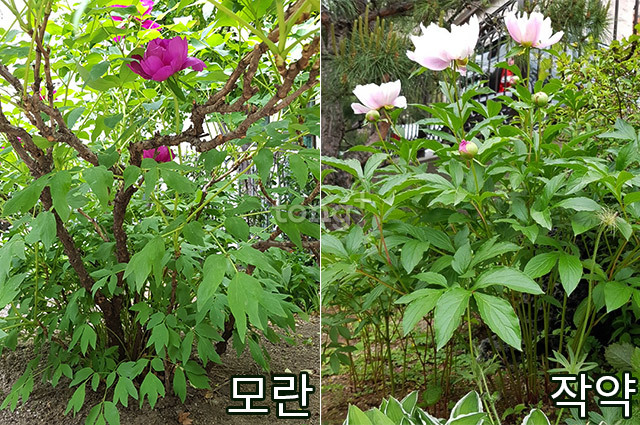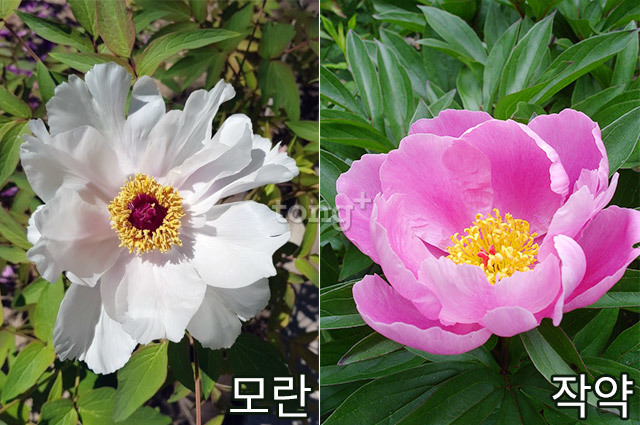Paeon, doctor who killed by his teacher, Asclepius
Mu Dan and Shao Yao
 |
| Mu Dan tree (left) and Shao Yao plant(right) |
 |
| Mu Dan flower (left) and Shao Yao flower (right), both colors can be varied |
| Mu Dan Pi | Bai Shao | Chi Shao | |
|---|---|---|---|
| Name in Chinese | 牧丹皮 | 白芍 | 赤芍 |
| Latin Name | Moutan Cortex | Paeoniae Radix alba | Paeoniae Radix rubra |
| Definition | Moutan root bark | White peony root | Red peony root |
| Temperature and Taste | Cold, bitter, acrid | Cool, sour, bitter | Cold, sour, bitter |
| Channels Entered | Heart, Liver, Kidney | Liver, Spleen | Liver, Spleen |
| Dosage | 6~12g | 6~15g | 6~15g |
| Actions in Traditional Chinese Medicine | Clears heat and cools blood, invigorates blood and dispels blood stasis, dissipates swelling and expels pus | Nourishes blood and regulates menstruation, calms the liver, relieves pain, preserves yin and stops perspiration | Invigorates blood and relieves pain, clears heat and cools blood |
The distinction in therapeutic use and properties between Chi Shao and Bai Shao began during the Northern Song Dynasty, as noted in the Kaibao Bencao (973–934 AD) and Taiping Shenghui Fang (978–992 AD). The differences and varying applications had a significant impact on the medical practices of the Jin and Yuan dynasties.
In the Ming and Qing dynasties, the Materia Medica of South Yunnan and Introduction to Medicine described Chi Shao and Bai Shao as two different compounds. These works also specified the organs targeted by these drugs and the processing methods used. Subsequent physicians built specific prescriptions based on this knowledge, further developing their use based on clinical experience.
 |
| Bai Shao and Chi Shao |
Raw Materials of Chi Shao and Bai Shao
Chi Shao and Bai Shao originate from the root of the peony plant, sharing many common characteristics on a biological level.
Chi Shao is the dried root of the peony, predominantly sourced from wild plants. It is primarily produced in regions like Inner Mongolia, Heilongjiang, Liaoning, and Sichuan.
Bai Shao, on the other hand, undergoes a process of boiling and peeling before drying. This root is mainly cultivated and produced in Anhui, Zhejiang, and Hangzhou.
Today, the two variants are differentiated based on processing methods, whether they are wild or cultivated, regions of production, and constituent content, according to the Chinese Pharmacopoeia Commission (2015). Chi Shao, primarily from wild sources, does not undergo processing, while Bai Shao, mostly cultivated, requires a series of processing steps.
During the processing, volatile constituents can easily be lost, and chemical transformations can occur. Both Chi Shao and Bai Shao contain paeoniflorin and polyphenolic components, but the levels are higher in Chi Shao. However, Bai Shao has higher levels of albiflorin, oxypaeoniflorin, monoterpene glycosides(excluding paeoniflorin).
Additionally, Bai Shao undergoes fumigation with sulfur to enhance its appearance and preservation, which alters its chemical composition. For example, paeoniflorin sulfonate, not naturally occurring, can be detected in sulfur-treated Bai Shao. However, this fumigation alters the drug's pharmacokinetics and can potentially reduce its safety and efficacy. Therefore, sulfur fumigation is not recommended.
My humble Opinion about Bai Shao and Chi Saho
In China, the origin plants are considered different, while in Korea, the same plant is used, differentiated only by the presence or absence of the peel. Modern Chinese medicine teaches that white peony tonifies blood, while red peony invigorates blood. However, according to ancient texts, it is actually the white peony that invigorates blood.
The complexity of traditional herbs has increased in modern times, often without sufficient textual or clinical evidence to support such distinctions.
Pharmacological Action
a. Chi Shao: liver and cardiovascular system
Evidence suggests Chi Shao has various pharmacological actions, particularly protective effects on the liver and cardiovascular circulation. These protective effects are attributed to the presence of paeoniflorin, ethyl palmitate, and ethyl linoleate. Studies suggest that paeoniflorin in Chi Shao regulates glutathione and shows anti-fibrotic activity in the liver. In the cardiovascular system, paeoniflorin suppresses inflammation and iNOS signaling pathways. It alleviates myocardial infarction, cardiac hypertrophy, fibrosis, inflammation, and improves left ventricular function. It also lowers blood pressure and suggests a role in the relaxation of vascular smooth muscles.
b. Bai Shao: nervous and immune systems, anti-cholinergic activity
Bai Shao has various pharmacological effects, notably on the nervous and immune systems. It offers therapeutic effects such as neuroprotection, anti-depressant properties, sedation, analgesia, and anticonvulsant activities. Albiflorin, a major constituent of Bai Shao, reduces neuronal nitric oxide synthase (nNOS) levels and shows anti-cholinergic activity. Experimental data suggest that albiflorin has potential as an anti-depressant drug.
Shared pharmacological actions: Both Chi Shao and Bai Shao contain similar constituents, offering anti-inflammatory and anti-tumor activities, mainly due to the presence of paeoniflorin and paeonol.
In Modern TCM
a. Bai Shao, 白芍, Paeoniae Radix alba
① Definition/ Temperature and Taste/ Channels entered/ Dosage
White peony root/ cool, sour, bitter/ Liver, Spleen/ 6~15g
② Actions
Nourishes blood and regulates menstruation
Calms the Liver and relieves pain
Preserves yin and stops perspiration
b. Chi Shao, 赤芍, Paeoniae Radix rubra
① Definition/ Temperature and Taste/ Channels entered/ Dosage
Red peony root/ cold, sour, bitter/ Liver, Spleen/ 6~15g
② Actions
Invigorates blood and relieves pain
Clears heat and cools blood
| Chi Shao | Bai Shao | |
|---|---|---|
| Origin | Dried root of peony | Root of peony after boiling and peeling |
| Source | Predominantly wild plants | Cultivated |
| Production regions | Inner Mongolia, Heilongjiang, Liaoning, and Sichuan | Anhui, Zhejiang, and Hangzhou |
| Processing | No processing | Requires boiling, peeling, and drying |
| Constituents | Higher levels of paeoniflorin and polyphenolic components | Higher levels of albiflorin, oxypaeoniflorin, monoterpene glycosides(excluding paeoniflorin) |
| Pharmacological Action | Liver and cardiovascular system protection | Therapeutic effects on nervous and immune systems, anti-cholinergic activity |
| Temperature and Taste | Cold, sour, bitter | Cool, sour, bitter |
| Channels Entered | Liver, Spleen | Liver, Spleen |
| Dosage | 6~15g | 6~15g |
| Actions in TCM | Invigorates blood and relieves pain, clears heat and cools blood | Nourishes blood and regulates menstruation, calms the liver, relieves pain, preserves yin and stops perspiration |
Summary and Implications
In China, Bai Shao (White Peony) and Chi Shao (Red Peony) are differentiated by species.
In Korea, they are considered the same plant, distinguished only by the presence or absence of the peel.
In modern traditional Chinese medicine, Bai Shao is commonly taught as a herb that 'tonifies blood', while Chi Shao is taught as a herb that 'invigorates blood'. However, according to the 'Ben Cao Jing Ji Zhu(本草經集注)', a classic Chinese medical text, Chi Shao is described as a herb that 'promotes urine and descends qi', while Bai Shao is described as a herb that 'invigorates blood and stops pain'. This suggests that Bai Shao is actually the herb that 'invigorates blood'.
중국- 기원식물이 다르다
한국- 동일한 것을 사용한다. 시중에서는 껍질의 유무에 따라 나눈다.
흔히 현대 중의학에서 백작은 보혈(tonify blood)하고, 적작은 산혈(invigorate blood)한다고 가르친다. 그러나, 本草經集注에 따르면, 적작약은 promote urine and desced qi, 백작약은 invigorate blood and stop pain한다고 하였으니, 백작약이야말로 산혈하는 것이다.
References
[1] Tan YQ et al. Efficacy, Chemical Constituents, and Pharmacological Actions of Radix Paeoniae Rubra and Radix Paeoniae Alba. Front Pharmacol. 2020 Jul 10;11:1054. doi: 10.3389/fphar.2020.01054. PMID: 32754038; PMCID: PMC7365904.
[2] Feng C, Liu M, Shi X, et al. Pharmacokinetic properties of paeoniflorin, albiflorin and oxypaeoniflorin after oral gavage of extracts of Radix Paeoniae Rubra and Radix Paeoniae Alba in rats. J Ethnopharmacol. 2010;130(2):407-413. doi:10.1016/j.jep.2010.05.028
[3] https://tnknam.tistory.com/933
[4] https://blog.naver.com/lefhod0706/222104017531
[5] https://www.joongang.co.kr/article/21613804#home


